When installing Active Roles out-of-the-box, the Directory Management > Tree > Azure node of the Active Roles Web Interface only contains an empty Azure Configuration sub-node by default.
To manage Azure AD directory objects (Azure users, guest users, contacts, O365 groups and Azure Security groups, and so on), you must specify an Azure tenant and configure Active Roles as a consented Azure application for it in the Active Roles Configuration Center.
NOTE: If you have already used an Azure tenant (or tenants) in a previous version of Active Roles, you can import and reconfigure them in two ways:
-
If you perform an in-place upgrade of Active Roles (that is, you install the latest version without uninstalling the previous version of Active Roles first in one of the supported upgrade paths), you can reauthenticate the existing Azure tenants with the Upgrade configuration wizard upon launching the Active Roles Configuration Center after installation.
For more information on reauthenticating Azure tenants this way, see Reconfiguring Azure tenants during upgrade configuration in the Active Roles 7.6 Quick Start Guide. For more information on the supported upgrade paths, see Version upgrade compatibility chart in the Active Roles 7.6 Release Notes.
-
If you install a new version of Active Roles to a machine that does not have any earlier versions of the software installed (either because it has been already uninstalled, or it has been installed on another machine), you can import your existing Azure tenant(s) by importing your Azure AD configuration. Following the import, you can reconsent your Azure tenants manually.
For more information on importing existing Azure tenants this way, see Importing an Azure tenant and consenting Active Roles as an Azure application.
Prerequisites
The Active Roles Administration Service must be already running. If the service is not running, then:
-
Open the Active Roles Configuration Center.
-
Navigate to the Administration Service page.
-
Click Start.
TIP: If the Active Roles Administration Service is not running, the Azure AD Configuration page indicates it with an on-screen warning.

To configure a new Azure tenant (or tenants) and set Active Roles as a consented Azure application
-
In the Active Roles Configuration Center, on the left pane, click Azure AD Configuration.

-
From the drop-down list, select the type of domain assigned to the new Azure AD tenant:
-
Non-Federated Domain: When selected, on-premises domains are not registered in Azure AD, and Azure AD Connect is not configured. Azure users and Azure guest users are typically created with the onmicrosoft.com UPN suffix.
-
Federated Domain: On-premises domains are registered in Azure AD and Azure AD Connect. Also, Active Directory Federation Services (ADFS) is configured. Azure users and Azure guest users are typically created with the UPN suffix of the selected on-premises domain.
-
Synchronized Identity Domain: On-premises domains may or may not be registered in Azure AD. Azure AD Connect is configured. Azure users and Azure guest users can be created either with the selected on-premises domain, or with the onmicrosoft.com UPN suffix.
-
To configure a new Azure tenant, click Add.
-
Authenticate your Azure AD administrator account.
-
If you already used one or more Azure AD administrator accounts on your PC, select your account from the Pick an account list, then provide the account password. If you do not find your account in the list, specify your account by clicking Use another account.
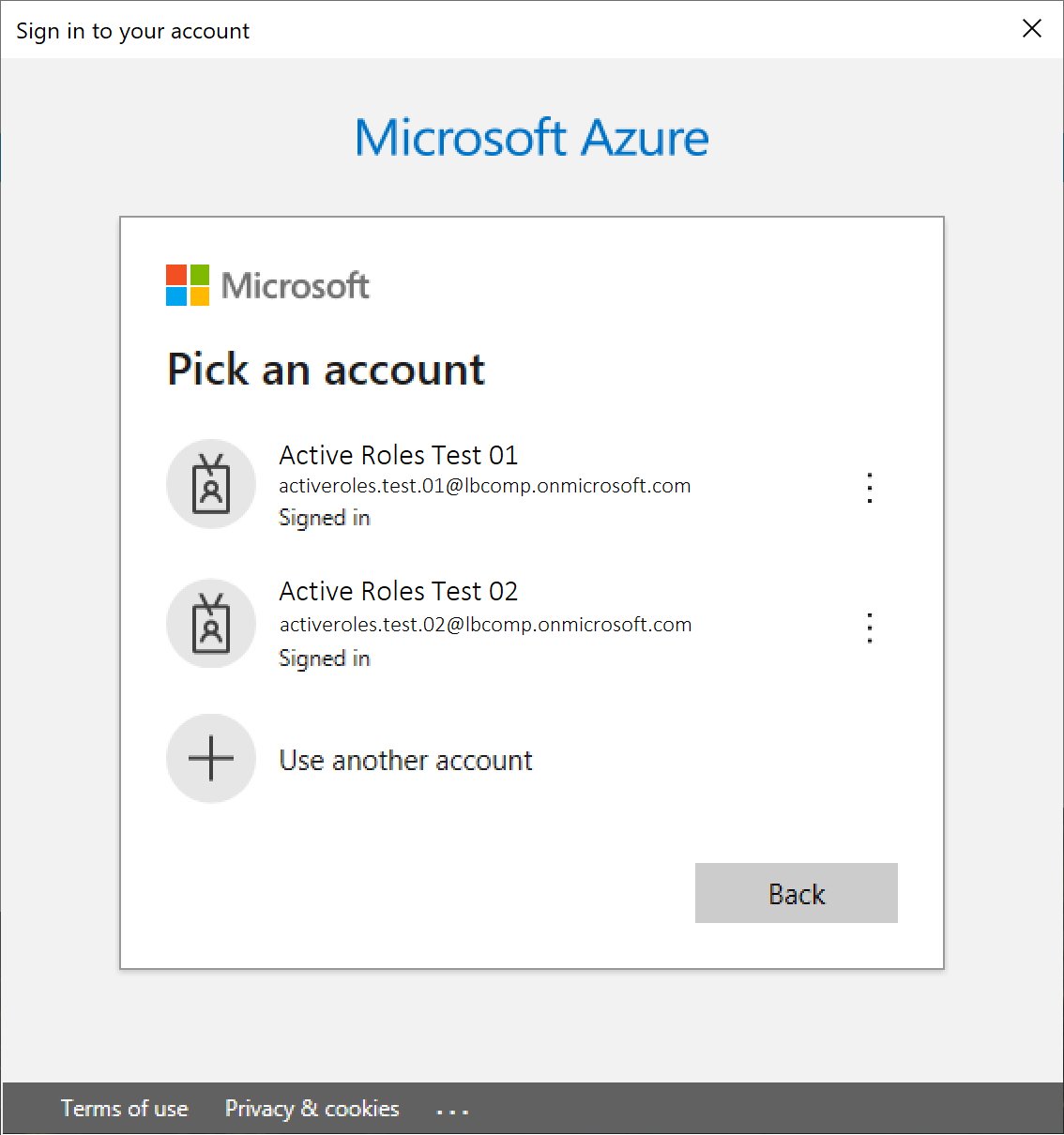
-
If you have not used any Azure AD administrator accounts yet on the PC (for example, because you are configuring a fresh Active Roles installation), specify your account user name in the Sign in field, then provide your password.
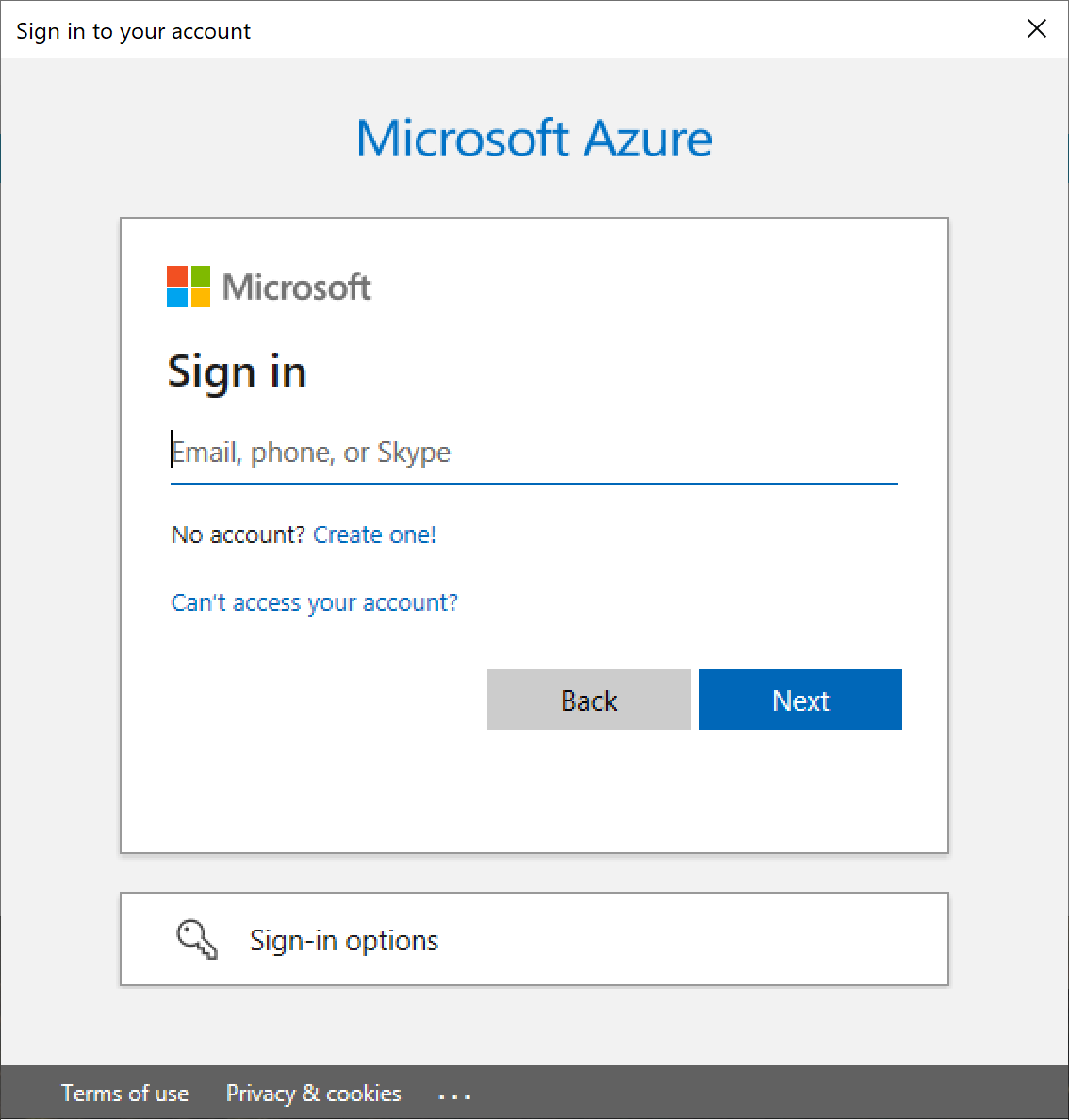
NOTE: Do not specify an account that has already been used to add an Azure tenant. You can only add a single Azure tenant with the same Azure AD account. Specifying an administrator account that is already linked to an Azure tenant will result in an error.
Upon successful authentication, the new Azure tenant appears in the list.

-
To manage the Azure tenant and its contents in the Active Roles Web Interface, you must consent Active Roles as an Azure application. To do so, click Consent next to the Azure tenant.
-
Authenticate your Azure AD administration account again. Depending on the type of Microsoft pop-up that appears (Pick an account or Sign in), either select the Azure AD account you used for adding the Azure tenant, or specify its user name and password again.
NOTE: Make sure to specify the account used for adding the Azure tenant (that is, the account name listed under the Name column of the Azure tenant). Authenticating with another account will result in an error.
-
The standard Microsoft Permissions requested pop-up appears, listing all the permissions required for configuring Active Roles as an Azure application. To finish creating the Azure application, click Accept.
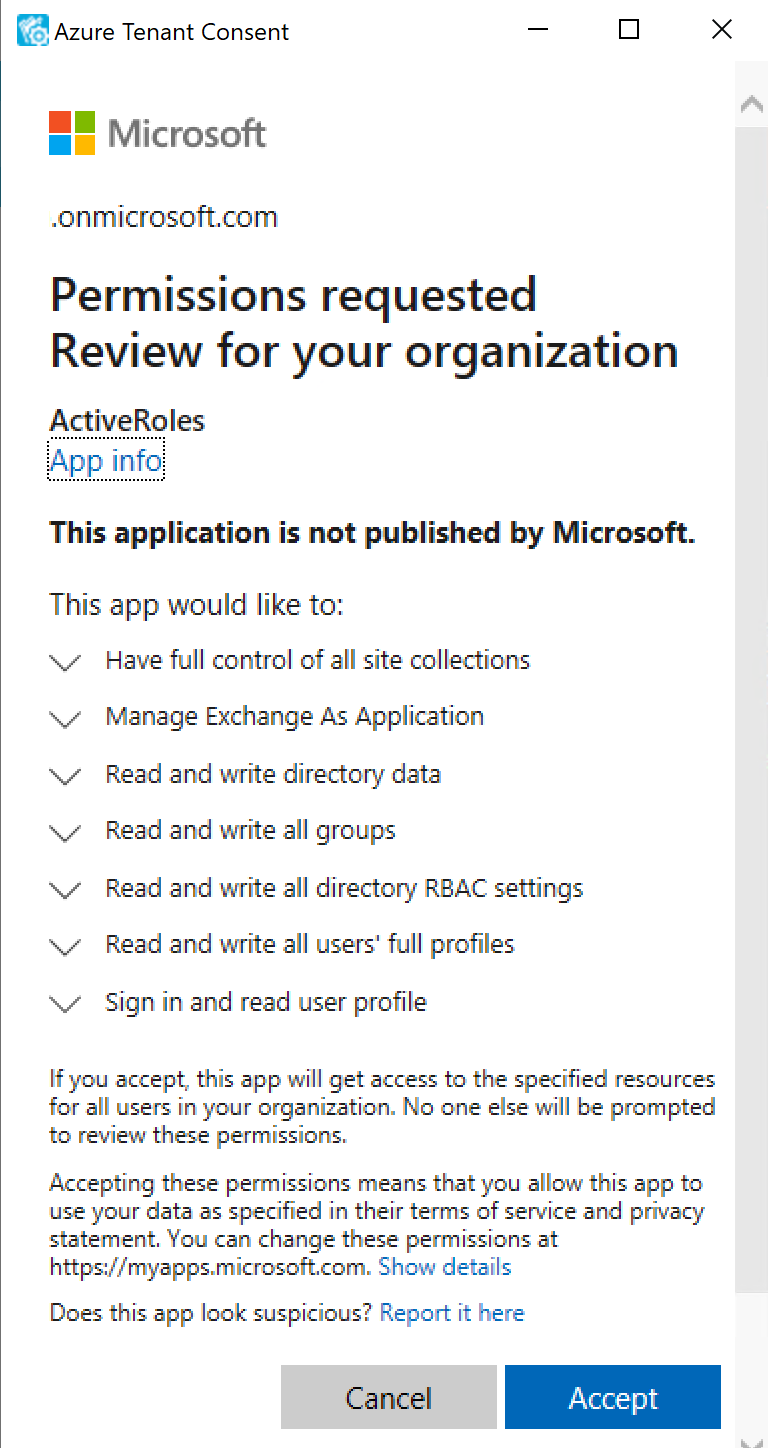
Active Roles then authenticates every Azure AD administrative operation performed in the Azure tenant with a set of generated client ID and client secret.
NOTE: Once you click Accept, Windows may show a Security Warning pop-up with the following message:
The current webpage is trying to open a site on your intranet. Do you want to allow this?
In such cases, clicking either Yes or No could freeze the pop-up dialog, but consenting the Azure tenant will finish without problem.
This issue can occur in case the computer running Active Roles has incorrect browser settings. As a workaround, to get an up-to-date status of the state of the Azure tenant, close and restart the Active Roles Configuration Center after clicking Yes in the Security Warning pop-up.
-
If you have additional Azure tenants to add and consent, configure them as described in the previous steps of this procedure.
-
To make the configured Azure tenant(s) appear in the Active Roles Web Interface, you must restart the Administration Service, as indicated on the user interface. Click Administration Service on the left pane, then either click Restart, or first click Stop and then Start.

TIP: Once the Azure tenant or tenants are configured, and Active Roles is also set as a consented Azure AD application for it, you can view and modify the configured tenant(s) and their settings at the following locations:
-
To change the domain type or OneDrive provisioning settings of an Azure tenant, in the Active Roles Configuration Center, navigate to Azure AD Configuration, select the Azure tenant, and click Modify. For more information, see Viewing or modifying the Azure AD tenant type.
-
To check the connectivity status of the Azure configuration, in the Active Roles Web Interface, navigate to Directory Management > Tree > Azure > Azure Configuration > Azure Health Check. For more information, see View Azure Health for Azure AD tenants and applications .
-
To check the Azure Licenses Report, in the Active Roles Web Interface, navigate to Directory Management > Tree > Azure > Azure Configuration > Azure Licenses Report. For more information, see View Azure Licenses Report .
-
To check the Office 365 Roles Report, in the Active Roles Web Interface, navigate to Directory Management > Tree > Azure > Azure Configuration > Office 365 Roles Report. For more information, see View Office 365 Roles Report .
NOTE: Consider the following when configuring an Azure tenant:
-
When Active Roles is registered as a consented Azure AD application, minimal permissions are assigned to it by default. To add additional permissions to the Azure application, sign in to the Azure Portal and add your required permissions there.
-
Azure Multi-Factor Authentication (MFA) is automatically enforced for Azure users and Azure guest users added to the configured Azure tenant. To disable Azure MFA for the Azure tenant, sign in to the Azure Portal and navigate to Tenant > Properties > Manage Security defaults and set Enable Security defaults to No.
If you have previously managed an Azure AD deployment, but you are not upgrading from a previous version of Active Roles via in-place upgrade (for example, because the previous version of Active Roles has been uninstalled before installing the new version), you can import, reauthenticate and consent existing Azure tenants via the Active Roles Configuration Center.
NOTE: Consider the following if you have not used any Azure tenants earlier, or if you installed the latest version of Active Roles via in-place upgrade:
-
If you have installed Active Roles out-of-the-box, and no Azure AD environment has been used previously in your organization, you must specify a new Azure tenant to manage Azure directory objects (such as Azure users, guest users, contacts, O365 groups or Azure Security groups). For more information, see Configuring a new Azure tenant and consenting Active Roles as an Azure application.
-
If you perform an in-place upgrade of Active Roles (that is, you install the latest version without uninstalling the previous version of Active Roles first in one of the supported upgrade paths), you can reauthenticate the existing Azure tenants with the Upgrade configuration wizard upon launching the Active Roles Configuration Center after installation.
For more information on reauthenticating Azure tenants this way, see Reconfiguring Azure tenants during upgrade configuration in the Active Roles 7.6 Quick Start Guide. For more information on the supported upgrade paths, see Version upgrade compatibility chart in the Active Roles 7.6 Release Notes.
To import and reauthenticate an Azure tenant and set Active Roles as a consented Azure application
-
Stop the Active Roles Administration Service. To do so, in the Active Roles Configuration Center, on the left pane, navigate to Administration Service and click Stop.

-
Once the Active Roles Administration Service stopped, open the Import configuration wizard by clicking Active Roles databases > Import configuration.
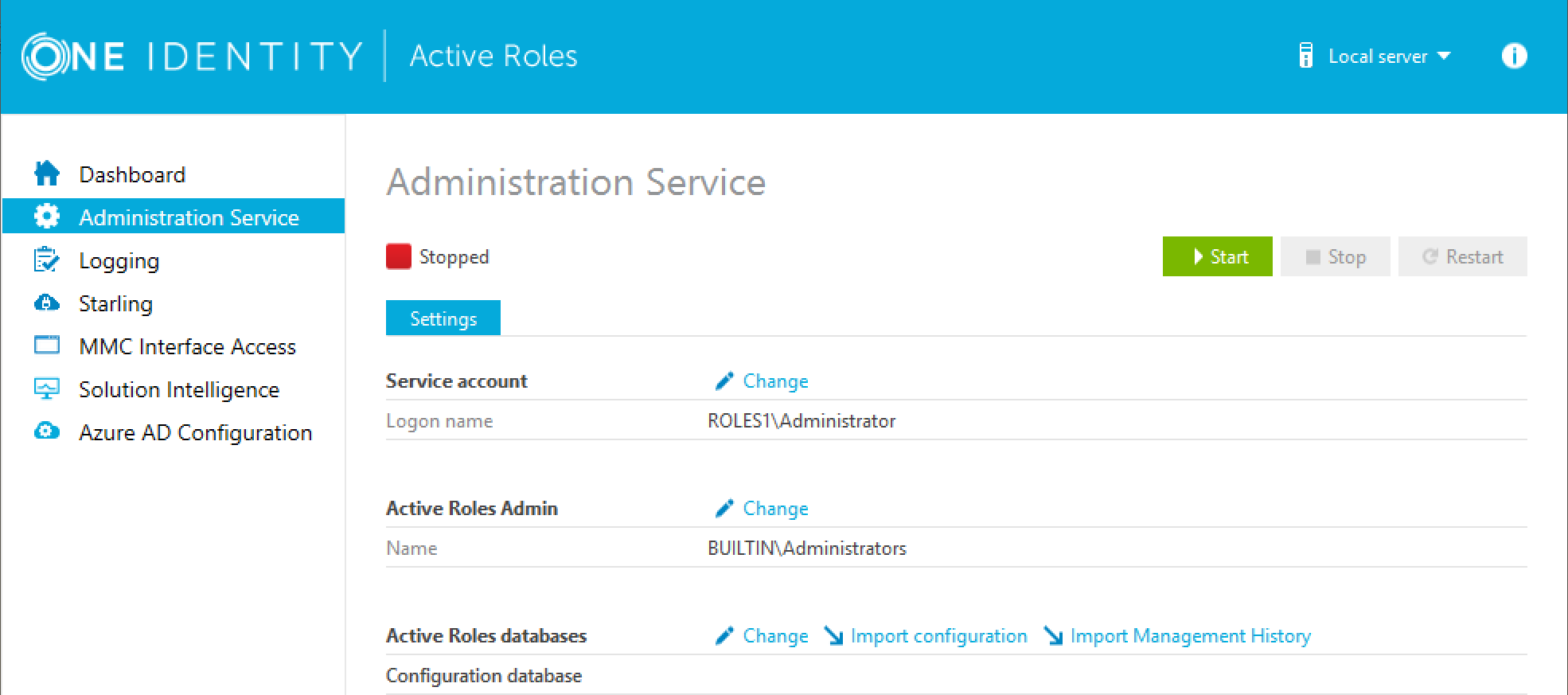
-
Perform the steps of the wizard. For more information, see Import configuration data or Steps to deploy the Administration Service in the Active Roles Quick Start Guide.
|

|
CAUTION: Importing a configuration will overwrite every Azure tenant currently listed in the Azure AD Configuration page with those included in the imported configuration. |
-
Once the import procedure finished, start the Active Roles Administration Service by clicking Start in the Administration Service page.
-
In the Active Roles Configuration Center, on the left pane, click Azure AD Configuration.
The list of imported Azure tenants appears.

-
To configure an imported Azure tenant, click Reauthenticate.
-
Authenticate your Azure AD administrator account.
-
If you already used one or more Azure AD administrator accounts on your PC, select your account from the Pick an account list, then provide the account password. If you do not find your account in the list, specify your account by clicking Use another account.

-
If you have not used any Azure AD administrator accounts yet on the PC (for example, because you are configuring a fresh Active Roles installation), specify your account user name in the Sign in field, then provide your password.

NOTE: Make sure to specify the account used for adding the Azure tenant (that is, the account name listed under the Name column of the Azure tenant). Authenticating with another account will result in an error.
-
To manage the Azure tenant and its contents in the Active Roles Web Interface, you must consent Active Roles as an Azure application. To do so, click Consent next to the Azure tenant.
-
Authenticate your Azure AD administration account again. Depending on the type of Microsoft pop-up that appears (Pick an account or Sign in), either select the Azure AD account you used for adding the Azure tenant, or specify its user name and password again.
NOTE: Make sure to specify the account used for adding the Azure tenant (that is, the account name listed under the Name column of the Azure tenant). Authenticating with another account will result in an error.
-
The standard Microsoft Permissions requested pop-up appears, listing all the permissions required for configuring Active Roles as an Azure application. To finish creating the Azure application, click Accept.

Active Roles then authenticates every Azure AD administrative operation performed in the Azure tenant with a set of generated client ID and client secret.
NOTE: Once you click Accept, Windows may show a Security Warning pop-up with the following message:
The current webpage is trying to open a site on your intranet. Do you want to allow this?
In such cases, clicking either Yes or No could freeze the pop-up dialog, but consenting the Azure tenant will finish without problem.
This issue can occur in case the computer running Active Roles has incorrect browser settings. As a workaround, to get an up-to-date status of the state of the Azure tenant, close and restart the Active Roles Configuration Center after clicking Yes in the Security Warning pop-up.
-
To make the configured Azure tenant(s) appear in the Active Roles Web Interface, you must restart the Administration Service, as indicated on the user interface. Click Administration Service on the left pane, then either click Restart, or first click Stop and then Start.

TIP: Once the Azure tenant or tenants are configured, and Active Roles is also set as a consented Azure AD application for it, you can view and modify the configured tenant(s) and their settings at the following locations:
-
To change the domain type or OneDrive provisioning settings of an Azure tenant, in the Active Roles Configuration Center, navigate to Azure AD Configuration, select the Azure tenant, and click Modify. For more information, see Viewing or modifying the Azure AD tenant type.
-
To check the connectivity status of the Azure configuration, in the Active Roles Web Interface, navigate to Directory Management > Tree > Azure > Azure Configuration > Azure Health Check. For more information, see View Azure Health for Azure AD tenants and applications .
-
To check the Azure Licenses Report, in the Active Roles Web Interface, navigate to Directory Management > Tree > Azure > Azure Configuration > Azure Licenses Report. For more information, see View Azure Licenses Report .
-
To check the Office 365 Roles Report, in the Active Roles Web Interface, navigate to Directory Management > Tree > Azure > Azure Configuration > Office 365 Roles Report. For more information, see View Office 365 Roles Report .
NOTE: Consider the following when configuring an Azure tenant:
-
When Active Roles is registered as a consented Azure AD application, minimal permissions are assigned to it by default. To add additional permissions to the Azure application, sign in to the Azure Portal and add your required permissions there.
-
Azure Multi-Factor Authentication (MFA) is automatically enforced for Azure users and Azure guest users added to the configured Azure tenant. To disable Azure MFA for the Azure tenant, sign in to the Azure Portal and navigate to Tenant > Properties > Manage Security defaults and set Enable Security defaults to No.
Use the Active Roles Administration Center to view or modify the tenant type of an existing Azure AD tenant. This is useful if you need to change the default domain settings of an Azure tenant due to an IT or organizational change.
NOTE: Consider the following limitations when modifying the properties of the selected Azure AD tenant:
-
If you set the tenant type of an on-premises or hybrid Azure AD to Federated Domain or Synchronized Identity Domain, then the Azure properties fields of the objects (Azure users, Azure guest users, groups and contacts) in the Azure tenant will be disabled and cannot be edited in the Active Roles Web Interface.
-
You cannot modify the tenant ID and the authentication settings of the Azure AD tenant.
To view or modify the Azure AD tenant properties
-
In the Active Roles Configuration Center, on the left pane, click Azure AD Configuration.
The list of existing Azure AD tenants appears.

-
Select the Azure AD tenant you want to view or modify, then click Modify.
The Tenant details window appears.
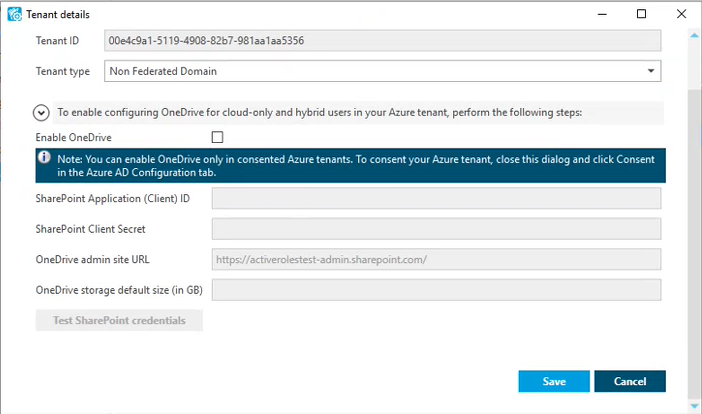
-
(Optional) To change the domain type of the Azure tenant, select the applicable type from the Tenant type drop-down list.
-
Non-Federated Domain: When selected, on-premises domains are not registered in Azure AD, and Azure AD Connect is not configured. Azure users and Azure guest users are typically created with the onmicrosoft.com UPN suffix.
-
Federated Domain: On-premises domains are registered in Azure AD and Azure AD Connect. Also, Active Directory Federation Services (ADFS) is configured. Azure users and Azure guest users are typically created with the UPN suffix of the selected on-premises domain.
-
Synchronized Identity Domain: On-premises domains may or may not be registered in Azure AD. Azure AD Connect is configured. Azure users and Azure guest users can be created either with the selected on-premises domain, or with the onmicrosoft.com UPN suffix.
-
(Optional) To enable, disable or modify the provisioned OneDrive storage of the Azure tenant, select or deselect Enable OneDrive, and (when selected), configure the SharePoint and OneDrive settings listed in the Tenant details window. For more information on configuring OneDrive storage in an Azure tenant, see Enabling OneDrive in an Azure tenant.
-
To close the Tenant details window without any changes, click Cancel. To apply your changes, click Save.
You can enable OneDrive in your consented Azure tenant(s) for cloud-only and hybrid Azure users in the Azure AD Configuration > Tenant details window of the Active Roles Configuration Center.

To enable OneDrive in an Azure tenant, you must:
-
Configure a SharePoint App-Only for authentication.
-
Specify the required application permissions for the configured SharePoint App-Only.
-
Specify the SharePoint admin site URL of your Azure tenant.
-
Configure the default size of the OneDrive storage provisioned for Azure users in the Azure tenant.
For the detailed procedure, see Configuring OneDrive for an Azure tenant.
NOTE: Once OneDrive is enabled, consider the following limitations:
-
Active Roles supports creating OneDrive storage for new cloud-only and hybrid Azure users only if OneDrive is preprovisioned in your organization. For more information, see Pre-provision OneDrive for users in your organization in the official Microsoft documentation.
-
When creating new cloud-only Azure users with OneDrive storage in the Active Roles Web Interface, make sure that the General > Allow user to sign in and access services setting is selected. Otherwise, Active Roles will not provision and create the OneDrive storage of the new Azure user. For more information on creating a new cloud-only Azure user in the Active Roles Web Interface, see Creating a new cloud-only Azure user.
-
The OneDrive admin site URL and OneDrive storage default size (in GB) settings of the Tenant details window are applicable to cloud-only Azure users only, and do not affect OneDrive provisioning for hybrid users in your Azure tenant. To configure the OneDrive admin site URL and the default OneDrive storage size for hybrid users, you must set these settings in the Active Roles Console (also known as the MMC Interface) by configuring an O365 and Azure Tenant Selection policy for your Azure tenant, after configuring OneDrive in the Active Roles Configuration Center. For more information, see Configuring an O365 and Azure Tenant Selection policy.












